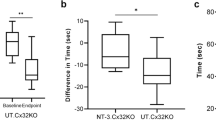Opinion statement
Charcot-Marie-Tooth (CMT), or heritable peripheral neuropathies, is among the most frequent genetic neuromuscular disorders, with a prevalence of approximately 1:2500. Since 1991, remarkable advances have occurred in determining the precise genetic cause of many forms of CMT and in generating animal models of many of these disorders. However, these advances have not yet resulted in cures for CMT. Recently, potential treatments for the most common form of CMT, CMT-1A, have been shown in rodent models of the disorder. Treatment with onapristone, a progesterone antagonist, has improved the neuropathy of the CMT-1A rat. Treatment with large doses of ascorbic acid (vitamin C) has improved the neuropathy of the CMT-1A mouse. Multicentric trials with ascorbic acid are likely to start in the near future to assess if vitamin C supplementation is effective and what is the dosage required in humans to improve neurologic disability. Because of potential side effects with antiprogesterone therapy, particularly in women of childbearing age, research is actively proceeding with progesterone antagonists to develop safe medications that also can be used in clinical trials of CMT-1A. Although no cures are available for CMT, there are many important treatments available for patients with CMT that can improve their quality of life and help them maintain their independence. Some of these therapies involve physiatry and orthopedic surgery. Others involve pain management. Lastly, there are potential concerns about medications or lifestyle issues that may exacerbate CMT. All of these issues will be discussed.
Similar content being viewed by others
References and Recommended Reading
Dyck PJ, Chance P, Lebo R, Carney JA: Hereditary motor and sensory neuropathies. In Peripheral Neuropathy, 3rd Edition. Edited by Dyck PJ, Thomas PK, Griffin SW, et al.: Philadelphia: WB Saunders; 1993:1094–1136.
Matsunami N, Smith B, Ballard L, et al.: Peripheral myelin protein-22 gene maps in the duplication in chromosome 17p11.2 associated with Charcot-Marie-Tooth 1A. Nat Genet 1992, 1:176–179.
Lupski JR, Garcia CA: Molecular genetics and neuropathology of Charcot-Marie-Tooth disease type 1A. Brain Pathol 1992, 2:337–349.
Shy ME, Jani A, Krajewski K, et al.: Phenotypic clustering in MPZ mutations. Brain 2004, 127:371–384.
Berciano J, Combarros O: Hereditary neuropathies. Curr Opin Neurol 2003, 16:613–622.
Yoshihara T, Kanda F, Yamamoto M, et al.: A novel missense mutation in the early growth response 2 gene associated with late-onset Charcot-Marie-Tooth disease type 1. J Neurol Sci 2001, 184:149–153.
Zuchner S, Mersiyanova IV, Muglia M, et al.: Mutations in the mitochondrial GTPase mitofusin 2 cause Charcot-Marie-Tooth neuropathy type 2A. Nat Genet 2004, 36:449–451.
Shy ME: Charcot-Marie-Tooth disease: an update. Curr Opin Neurol 2004, 17:579–585. This is a good overview focusing on the pathomechanisms of hereditary neuropathies, showing the role of axonal transport and abnormal protein trafficking in causing different forms of CMT.
Nelis E, Erdem S, Van Den Bergh PY, et al.: Mutations in GDAP1: autosomal recessive CMT with demyelination and axonopathy. Neurology 2002, 59:1865–1872.
Chance PF, Alderson MK, Leppig KA, et al.: DNA deletion associated with hereditary neuropathy with liability to pressure palsies. Cell 1993, 72:143–151.
Vinci P, Perelli SI: Footdrop, foot rotation and plantarflexor failure in Charcot-Marie-Tooth disease. Arch Phys Med Rehabil 2002, 83:513–516.
Mann RA, Missirian J: Pathophysiology of Charcot-Marie-Tooth disease. Clin Orthop 1988, 234:221–228. This is a very interesting paper describing in detail the pathogenesis of pes cavus.
Aitkens SG, McCrory MA, Kilmer DD, Bernauer EM: Moderate resistance exercise program: its effect in slowly progressive neuromuscular disease. Arch Phys Med Rehabil 1993, 74:711–715.
Kilmer DD, McCrory MA, Wright NC, et al.: The effect of a high resistance exercise program in slowly progressive neuromuscular disease. Arch Phys Med Rehabil 1994, 75:560–563.
Vinci P, Esposito C, Perelli SL, et al.: Overwork weakness in Charcot-Marie-Tooth disease. Arch Phys Med Rehabil 2003, 84:825–827.
Schwend RM, Drennan JC: Cavus foot deformity in children. J Am Acad Orthop Surg 2003, 11:201–211.
Sereda MW, Meyer zu Horste G, et al.: Therapeutic administration of progesterone antagonist in a model of Charcot-Marie-Tooth disease (CMT-1A). Nat Med 2003, 9:1533–1537. An important paper showing the therapeutic effects of antiprogesterone treatment.
Koenig HL, Schumacher M, Ferzaz B, et al.: Progesterone synthesis and myelin formation by Schwann cells. Science 1995, 268:1500–1503.
Passage E, Norreel JC, Noack-Fraissignes P, et al.: Ascorbic acid treatment corrects the phenotype of a mouse model of Charcot-Marie-Tooth disease. Nat Med 2004, 10:396–401. This paper shows the impressive results obtained by treating a mouse model of CMT1A with ascorbic acid, opening the field to human clinical trials with vitamin C.
Perea J, Robertson A, Tolmachova T, et al.: C: Induced myelination and demyelination in a conditional mouse model of Charcot-Marie-Tooth disease type 1A. Hum Mol Genet 2001, 10:1007–1018.
Author information
Authors and Affiliations
Rights and permissions
About this article
Cite this article
Grandis, M., Shy, M.E. Current therapy for Charcot-Marie-Tooth disease. Curr Treat Options Neurol 7, 23–31 (2005). https://doi.org/10.1007/s11940-005-0003-5
Issue Date:
DOI: https://doi.org/10.1007/s11940-005-0003-5




